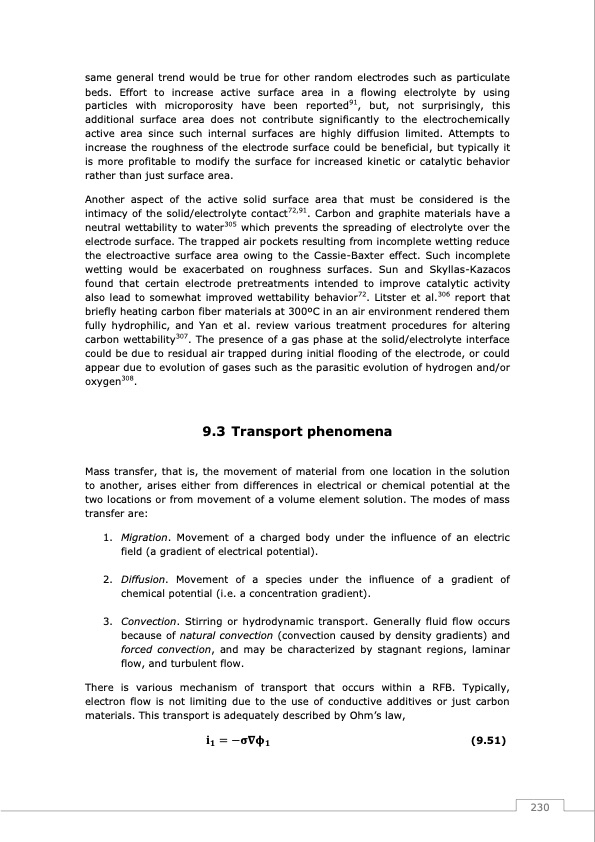
PDF Publication Title:
Text from PDF Page: 231
same general trend would be true for other random electrodes such as particulate beds. Effort to increase active surface area in a flowing electrolyte by using particles with microporosity have been reported91, but, not surprisingly, this additional surface area does not contribute significantly to the electrochemically active area since such internal surfaces are highly diffusion limited. Attempts to increase the roughness of the electrode surface could be beneficial, but typically it is more profitable to modify the surface for increased kinetic or catalytic behavior rather than just surface area. Another aspect of the active solid surface area that must be considered is the intimacy of the solid/electrolyte contact72,91. Carbon and graphite materials have a neutral wettability to water305 which prevents the spreading of electrolyte over the electrode surface. The trapped air pockets resulting from incomplete wetting reduce the electroactive surface area owing to the Cassie-Baxter effect. Such incomplete wetting would be exacerbated on roughness surfaces. Sun and Skyllas-Kazacos found that certain electrode pretreatments intended to improve catalytic activity also lead to somewhat improved wettability behavior72. Litster et al.306 report that briefly heating carbon fiber materials at 300oC in an air environment rendered them fully hydrophilic, and Yan et al. review various treatment procedures for altering carbon wettability307. The presence of a gas phase at the solid/electrolyte interface could be due to residual air trapped during initial flooding of the electrode, or could appear due to evolution of gases such as the parasitic evolution of hydrogen and/or oxygen308. 9.3 Transport phenomena Mass transfer, that is, the movement of material from one location in the solution to another, arises either from differences in electrical or chemical potential at the two locations or from movement of a volume element solution. The modes of mass transfer are: 1. Migration. Movement of a charged body under the influence of an electric field (a gradient of electrical potential). 2. Diffusion. Movement of a species under the influence of a gradient of chemical potential (i.e. a concentration gradient). 3. Convection. Stirring or hydrodynamic transport. Generally fluid flow occurs because of natural convection (convection caused by density gradients) and forced convection, and may be characterized by stagnant regions, laminar flow, and turbulent flow. There is various mechanism of transport that occurs within a RFB. Typically, electron flow is not limiting due to the use of conductive additives or just carbon materials. This transport is adequately described by Ohm’s law, (9.51) 230PDF Image | Redox Flow Batteries Vanadium to Earth Quinones

PDF Search Title:
Redox Flow Batteries Vanadium to Earth QuinonesOriginal File Name Searched:
FJVG_TESIS.pdfDIY PDF Search: Google It | Yahoo | Bing
Salgenx Redox Flow Battery Technology: Salt water flow battery technology with low cost and great energy density that can be used for power storage and thermal storage. Let us de-risk your production using our license. Our aqueous flow battery is less cost than Tesla Megapack and available faster. Redox flow battery. No membrane needed like with Vanadium, or Bromine. Salgenx flow battery
| CONTACT TEL: 608-238-6001 Email: greg@salgenx.com | RSS | AMP |